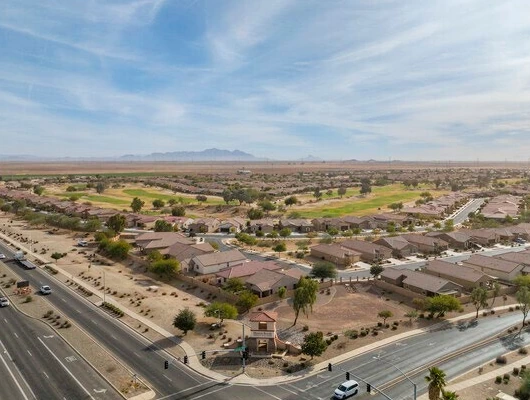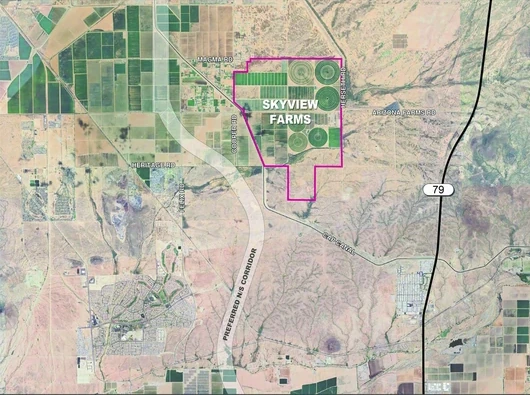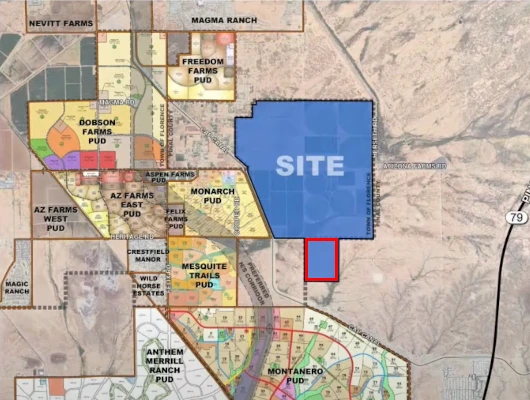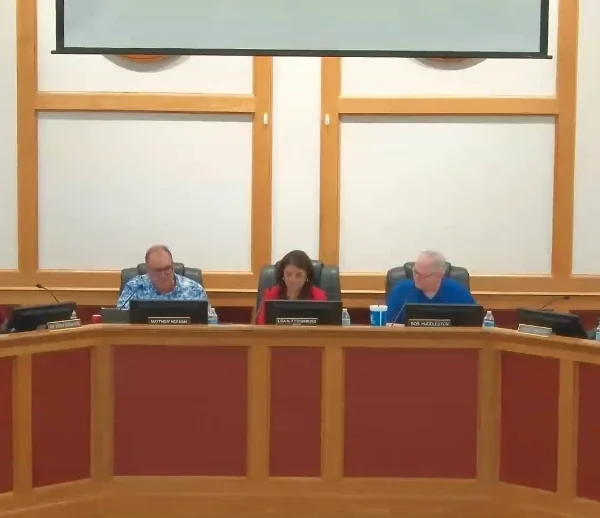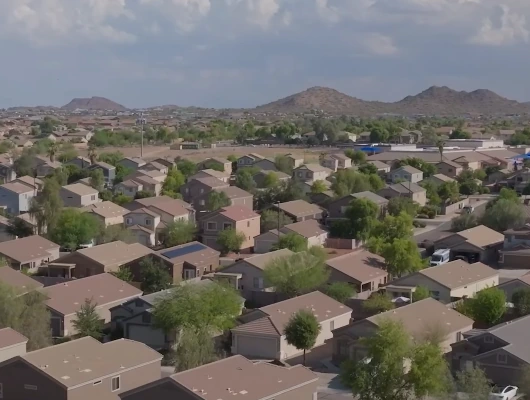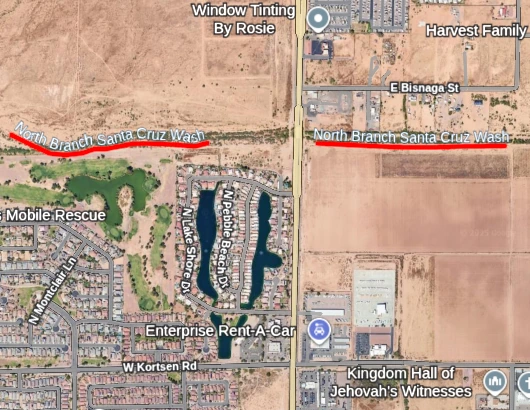Key Points
- Casa Grande is projected to add 9,800+ housing units by 2040 to meet population growth.
- Housing construction is shifting from mostly single-family homes to more apartments and rentals.
- Rents have dropped ~$100 from a 2022 peak, but affordability remains a major issue.
- 48% of renters pay more than 30% of their income on housing; 21% pay more than 50%.
- 56% of renter seniors are cost-burdened.
- Single mothers with children earn a median of $41,847, allowing them to afford only $1,046/month, while average rents are $1,350.
- Home prices have surged 64% since 2019, from $205,000 to $336,000.
- The typical Casa Grande household can afford a $238,000 home, well below the $345,000 median new home price.
- The plan sets a goal of 2,000 new or preserved affordable/workforce housing units by 2030.
- Possible solutions include a housing trust fund, GPLET tax incentives, community land trusts, voluntary inclusionary zoning, fee waivers, expedited permitting, and missing-middle housing types (duplexes, townhomes, small-lot homes).
- The presentation emphasizes that higher-density housing is critical to improving affordability.
Casa Grande rents have fallen $100 on average from their 2022 peak, yet nearly half of the city’s renters remain cost-burdened by housing expenses. The Casa Grande Planning and Zoning Commission received this sobering finding on November 6, 2025, during a comprehensive presentation on the city’s Affordable Housing Plan. Rick Merritt, president of Elliott D. Pollack & Company, presented the study’s findings to commissioners.
Merritt revealed that despite falling rents, the affordability crisis persists. According to the firm’s analysis, 47.8% of renters still pay more than 30% of their income on housing. The U.S. Department of Housing and Urban Development defines 30% as the federal affordability threshold.
The affordability gap reflects a widening disparity between income and housing costs. Median household income increased 35.2% from 2018 through 2023, rising from $49,069 to $66,354. However, single-family resale prices surged 64% since 2019—nearly double the rate of income growth.
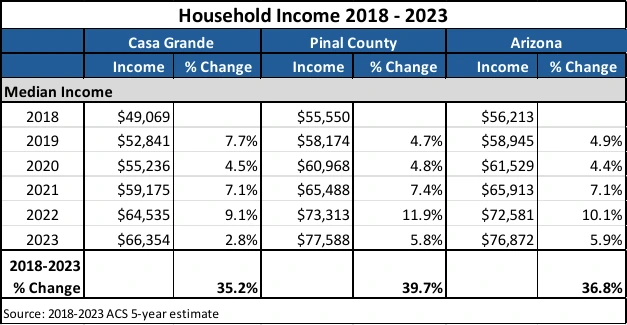
“You can see they’ve also jumped way up in price, 64% since 2019,” Merritt noted when discussing resale homes. “They come down in price some from 2022, but still way beyond what they were just four or five years ago.” Resale prices increased from $205,000 in 2019 to $335,990—a jump of about $131,000.
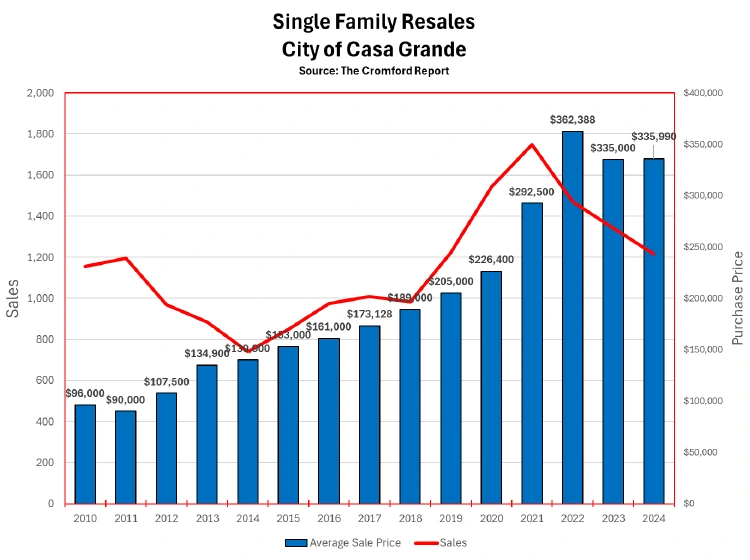
New home prices also surged dramatically, rising by almost $148,000 between 2019 and 2022. While prices have declined from their peak of about $385,000 to approximately $353,000 in 2024, they remain well above pre-pandemic levels.

Population Growth Demands Housing Supply
Casa Grande’s population stands at approximately 65,883 residents as of July 2024. The city is expected to grow to more than 76,000 people by 2030 and to more than 90,000 people by 2040.

Casa Grande’s economy is built on metal inputs, transportation-related manufacturing, consumer goods manufacturing, and healthcare industries. The city has maintained its position as Pinal County’s economic center for decades, with a robust manufacturing base providing stable employment.
“Because of your assets, we expect Casa Grande to continue to be the economic center of Pinal County,” Merritt said. “So, what does all that translate into for housing demand? That’s about 9,800 units over the next 15, 16 years. On an average basis, it’s about 600 units a year.”
Defining Affordable and Workforce Housing
Merritt clarified the distinction between affordable housing and workforce housing. Affordable housing typically refers to low and moderate income households earning less than 60% of the area median income, as determined by the U.S. Department of Housing and Urban Development.
For federal housing programs, Casa Grande falls within the Metro Phoenix metropolitan statistical area. This means affordable housing qualifications are calculated using the region’s median income rather than Casa Grande’s actual median. For a family of three, the 60% threshold is approximately $60,600—calculated using the Phoenix metro area’s median income. This creates problems because Casa Grande’s actual median household income is only $66,354. Many Casa Grande residents earning near their city’s median don’t qualify for affordable housing assistance because eligibility is based on the wealthier Phoenix region’s higher income levels.
The standard measure defines housing as affordable when residents pay no more than 30% of their income on housing costs. For renters, this includes rent and utilities. For homeowners, housing costs typically include mortgage payments, property taxes, and insurance.
“We’re talking about households that earn more than 60% of the median income,” Merritt explained. “They earn too much to provide assistance, but they often can’t find housing that’s affordable to them because of the increase in rents that we’ve seen. A lot of them are teachers, police, firefighters, construction workers, people that are really critical to the economy of the local area.”
According to wage data from the Arizona Office of Economic Opportunity and the U.S. Department of Labor, many essential workers struggle to afford local housing. A retail worker can afford only $692 per month after utilities. Paramedics can afford $922. Teachers can afford between $1,113 and $1,388. Firefighters can afford $1,305, while police officers can afford $1,717. Many local apartments exceed these thresholds.
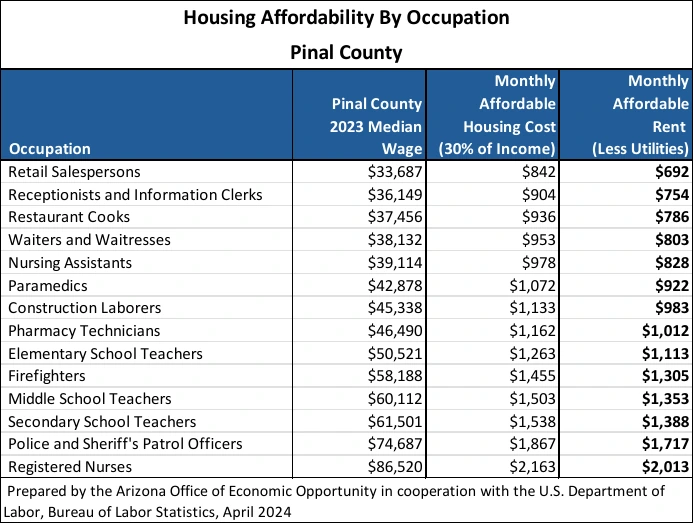
Housing Market Shifts Toward Multifamily Development
The presentation highlighted a dramatic shift in Casa Grande’s housing market. “You can see in 2021, a lot of single family building activity,” Merritt said. “But you get to 2023 and 2024, that’s where you’ve really seen the change towards multifamily housing.” Single-family permits have declined significantly while multifamily development has surged.
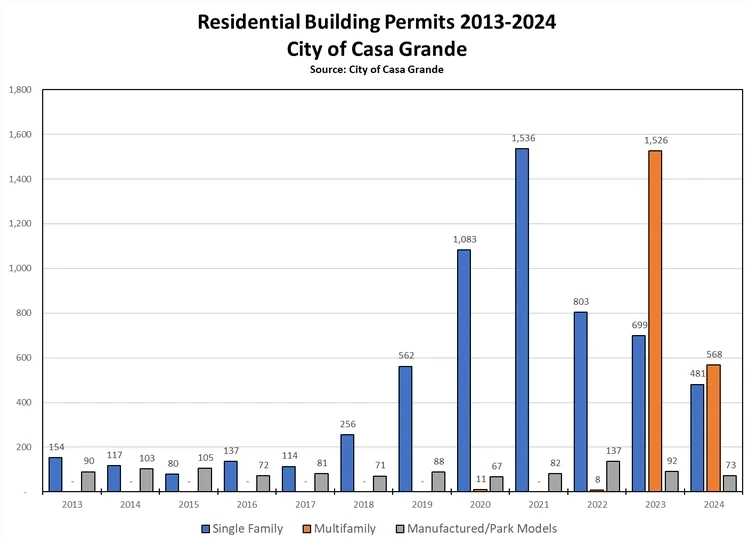
This transition reflects broader market forces unleashed during and after the pandemic. The influx of new apartment complexes has begun affecting rental prices.
Rental Rates Show Recent Decline
Average rents in Casa Grande peaked at $1,455 in the third quarter of 2022. Since then, rents have moderated by approximately $100 to $1,350 in the first quarter of 2025. The decline reflects increased supply from new complexes, rising vacancy rates, and rental concessions offered by property managers.
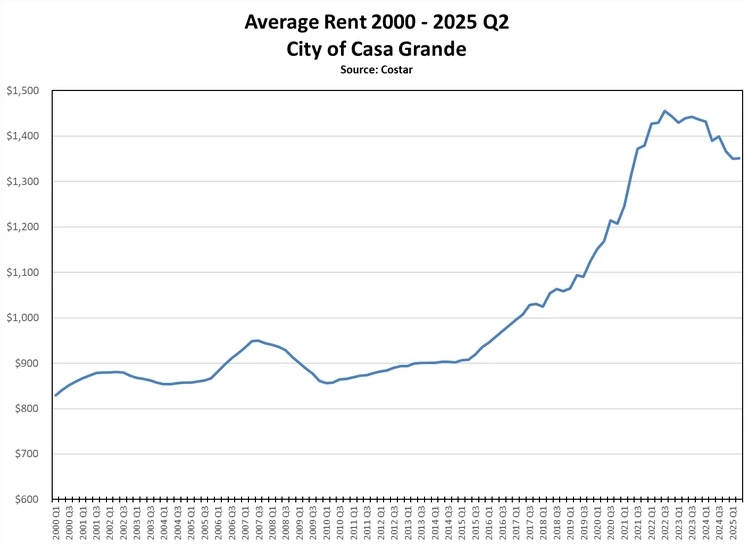
Nearly half of Casa Grande renters—47.8%—pay more than 30% of their income on housing. This percentage matches the statewide average but exceeds Pinal County’s rate of 40.1%. An estimated 20.8% of renter households are severely cost-burdened, spending more than 50% of their income on housing. This represents approximately 1,260 households.
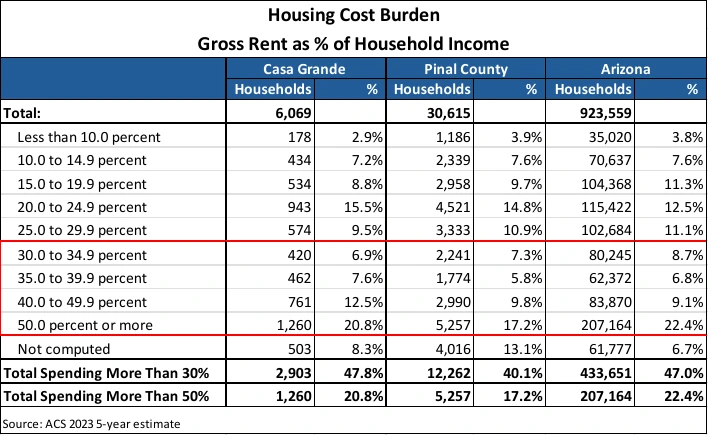
For households earning less than $50,000, the city faces a deficit of more than 710 rental units, while middle-income renters have a surplus of available housing. High-income renters earning above $100,000 also face limited options.
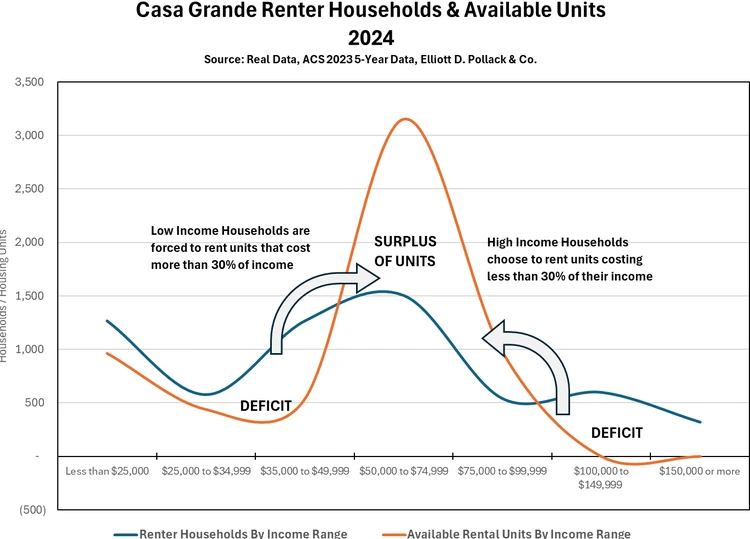
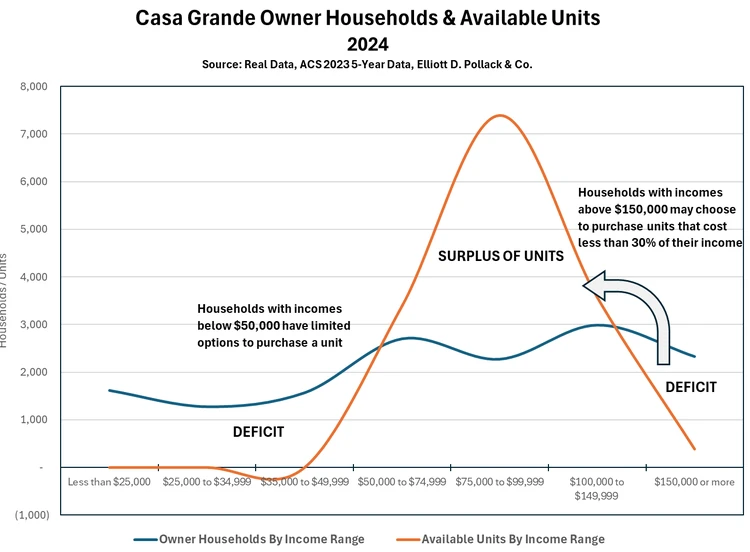
Home Prices Outpace Income
Based on the city’s median income of $66,513 and current interest rates around 6.6%, with a 10% down payment, the typical Casa Grande household can afford a home priced at approximately $238,000—well below the median new home price of $345,000.
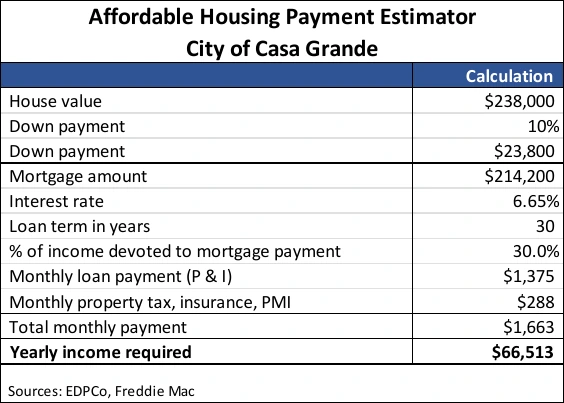
The median new home price of $345,000 requires a household income of $96,400—significantly above the city’s median.
The affordability gap for homeownership is severe for low-income families. Some 4,447 households earning less than $50,000 cannot afford any homes at current prices.
Cost Burden Affects Owners and Renters Differently
Merritt emphasized that owners have more options to reduce their burden than renters. “Owners of occupied housing units have more opportunity to reduce their burden,” he explained. “They can sell their home, they can move to a lower-cost unit perhaps, they can rent. So they have more opportunity. Renters are really stuck. They have no other opportunities, really in the marketplace.”
When combining both owners and renters, an estimated 6,307 households in Casa Grande—representing 30% of all households—are cost-burdened, paying more than 30% of their income on housing.
Female-Headed Households Face Severe Challenges
The presentation devoted special attention to female heads of household without a spouse. These families face particular vulnerability in the housing market.
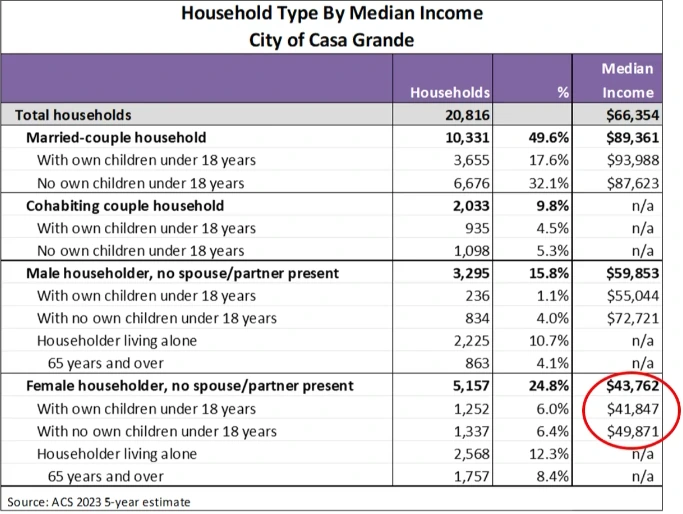
Female householders with children under 18 years of age have a median income of $41,847. By contrast, male householders with children earn well above that amount at $55,044. Married couples average nearly $90,000 in household income.
This income disparity severely limits housing options for single mothers. At $41,847 in annual income, these households can afford approximately $1,046 per month for housing including utilities. However, with average rents at $1,350 according to the presentation, these families are forced to spend well above the 30% affordability threshold.
The housing gap particularly affects this vulnerable population. Single mothers comprise a significant portion of the severely cost-burdened households in Casa Grande.
Seniors Experience High Housing Cost Burden
Seniors represent another at-risk group requiring focused attention. More than half of renter seniors—approximately 56%—pay more than 30% of their income on housing. Seniors aged 65 and older account for about 31.2% of all cost-burdened households in the city.
While some affordable senior housing facilities exist in the community, the presentation suggested the city needs more options for this demographic.
Higher Density Required for Affordability
The presentation made a direct connection between housing affordability and density. Merritt stated clearly that meeting affordability goals requires embracing higher-density development.
“We think that affordability really can’t be accomplished without higher density,” he told commissioners. While acknowledging that multifamily housing has generated concern in community meetings, he stressed that demand exists for all housing types including apartments.
The strategy proposes various housing forms between single-family homes and mid-rise apartments. These “missing middle” housing types include cluster complexes, duplexes, townhouses, courtyard buildings, and small-lot single-family development.
Cluster complexes, sometimes called six-packs or eight-packs by homebuilders, use shared driveways or alleys. Most include garages. The presenter noted that Casa Grande has not yet seen this housing type but suggested it as one option for achieving higher density.
Duplexes already exist in older parts of the city. The presentation suggested expanding this housing type in appropriate locations. Small-lot single-family development offers another strategy to reduce costs while preserving homeownership opportunities.
Additional housing types mentioned include accessory dwelling units for single-family home backyards, manufactured homes, apartments, and assisted living facilities. Manufactured housing has evolved significantly, with newer models closely resembling stick-built homes. The city already has manufactured home communities, mostly oriented toward retirees.
Ambitious Goal: 2,000 Affordable Units by 2030
The affordable housing plan sets a goal of creating or preserving 2,000 affordable and workforce housing units through 2030. Merritt acknowledged this as a challenging target but emphasized its necessity.
The goal includes both new construction and preservation of existing affordable housing. The city already has emergency rehabilitation funding through block grant programs. This funding helps maintain the current affordable housing stock, particularly in the downtown area where older, moderately priced homes provide important affordable options.
The city has also attracted several Low-Income Housing Tax Credit (LIHTC) developments, which use federal tax credits to incentivize private investment in affordable rental housing. Merritt praised the city’s success attracting these developments. “You’ve done very well with these tax credit projects,” he told commissioners. “They’ve come in, they make a lot of sense for the developers.”
Multiple Tools Proposed to Increase Supply
One significant option is establishing a housing trust fund. This fund would provide financing for affordable housing development.
The trust fund could address a key challenge: waiving impact fees for affordable housing projects. Development impact fees represent a significant cost for multifamily housing. However, cities cannot simply waive these fees without finding replacement funding. A housing trust fund could reimburse the city for waived impact fees, making affordable projects financially viable while preserving city revenue.
The Government Property Lease Excise Tax (GPLET) program offers another powerful tool. This state program reduces property tax burdens on qualifying developments. The City of Phoenix has used GPLETs extensively in its downtown, spurring construction of numerous residential high-rises. Casa Grande has used a GPLET for a manufacturing business in the past, and the presentation suggested extending this tool to housing developments.
Community land trusts represent another innovative approach. These nonprofit corporations own land and sell housing units to affordable housing buyers. By separating land ownership from home ownership, land trusts can reduce the purchase price by 15% to 25%.
The plan also recommends a voluntary inclusionary zoning program. Under this approach, developers requesting rezoning would be encouraged to include affordable units in their projects in exchange for approval or other benefits. As Vice Chairman Celeste Garza noted during the discussion, such incentives would need to be implemented at the code level through measures like reduced impact fees and permit fees.
Additional Strategies and Incentives
Beyond these major policy and financial tools, the plan proposes additional implementation strategies including density bonuses, use of city-owned and school district land for housing, land banking, expedited plan review, down payment assistance programs, permit fee waivers, impact fee reimbursement, reduced parking requirements, and construction sales tax waivers. The city’s Industrial Development Authority, which helped finance three apartment complexes in the 1980s, could be leveraged for affordable housing projects.
A voluntary inclusionary zoning program could encourage developers to include affordable units when requesting rezoning. Down payment assistance programs could help workforce families transition from renting to homeownership.
Implementation Timeline and Next Steps
The City Council will consider adopting the affordable housing plan in December 2025, which outlines various strategies and tools the city could implement to achieve the housing goal. The plan sets a primary goal of creating or preserving 2,000 affordable and workforce housing units through 2030, along with supporting objectives including maintaining existing affordable housing stock and establishing educational programs about the benefits of affordable housing.
